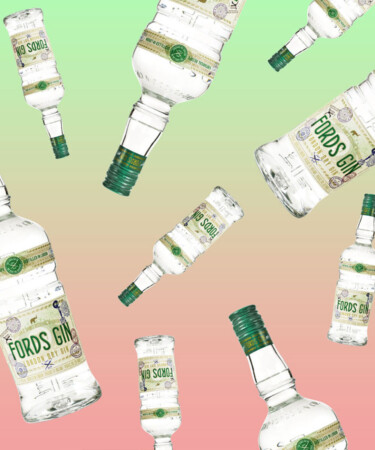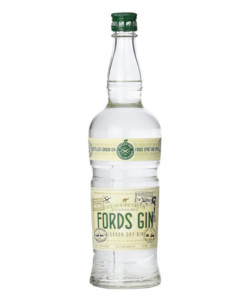With its multitude of delightful botanicals, gin can often be a difficult spirit to approach, especially when it comes to mixing cocktails. As each expression can contain varying types and amounts of botanicals, the gin that stars in a Bee’s Knees may be the same one that fails to hold up in a classic Martini. This was the dilemma that inspired bartender Simon Ford to create Fords Gin, a spirit designed to be equally punchy in every cocktail.
The spirit was also designed with a particular target audience in mind: bartenders. To perfect the recipe, Ford collaborated with a number of bar professionals from around the globe to ensure the final product accomplished exactly what it intended to: complement every cocktail in a bartender’s arsenal. Further, every element of the gin — down to the bottle’s composition — is designed with utility in mind for the drinks professional. Now that you know the basics, here are seven more things you should know about Fords Gin.
Creator Simon Ford got his start as a wine professional.
Simon Ford’s career in the beverage alcohol industry long precedes the release of Fords Gin in 2012. At the age of 19, Ford dropped out of university before beginning a job at a wine shop, where he spent five years refining his skills and training for his sommelier certification. Though most widely known now for his expertise in gin, interestingly enough, Ford was brought into the spirits space by serving as a marketing manager for Absolut Vodka — which was owned by Seagrams at the time — in 1996. A few years later, Plymouth Gin was purchased by Seagrams, which solidified Ford’s love for the spirit. In the early 2000s, after departing from Seagrams and opening his own cocktail bar, Ford became the brand ambassador for Plymouth Gin and was even awarded the title of “Best Brand Ambassador,” at 2007’s Tales of the Cocktail.
Iconic Milk & Honey founder Sasha Petraske had a hand in Fords’ creation.
At the time, Milk & Honey didn’t have a back bar, and Petraske was in the process of cultivating a strong selection of spirits to showcase in cocktails. While discussing his selections, Petraske lamented the lack of gins that work well in a number of cocktails. The two then set out on a journey to fill what they perceived to be an extreme gap in the market — one that supports all of gin’s complementary flavors while still allowing juniper to shine.
Fords Gin is made for bartenders, by bartenders.
To bring Fords Gin to the public, Ford teamed up with Jason Kosmas and Dushan Zaric — the founders of Employees Only, a New York City cocktail bar — to form The 86 Co., a brand focused on spirits “for bartenders, by bartenders.” In conjunction with some of the world’s best distilleries — like Thames Distillers in London — the spirits brand consulted a number of bartenders from around the world when developing each product to ensure each received their stamp of approval. Along with Fords, The 86 Co. also released Tequila Cabeza, Aylesbury Duck Vodka, and Caña Brava Rum. In 2019, the brand was acquired by Brown-Forman, which opted to only add Fords to its profile, and production of the remaining three spirits was phased out.
It took 83 tries to perfect the recipe.
Because Fords was created with mixology in mind, it was critical to perfect the proportion of each botanical added in order to prevent any one flavor from dominating. As such, it took the team 83 tries before landing on the perfectly balanced combination of nine botanicals to bottle and stock in their own bars’ wells. The final recipe is predominantly juniper and coriander seed, followed by equal amounts lemon, orange, and grapefruit peel, angelica, and jasmine, complemented by a whisper of cassia and orris. Each of the botanicals used in Fords Gin is imported by Joseph Flach & Sons Ltd., which has sourced both medicinal and culinary products for London’s tea houses and gin palaces since 1882.
Ford collaborated with an 11th-generation master distiller to refine his recipe.
To develop Fords into a product that could be widely distributed, Ford partnered with master distiller Charles Maxwell of Thames Distillers, whose family involvement with gin dates back to the 17th century. In 1681, Maxwell’s eighth great-grandfather started the family tradition of working in spirits when he apprenticed as a distiller in the City of London — 315 years later, in 1996, his great-great-great-(you get it)-grandson opened his very own distillery in the same city. In addition to Fords Gin, Thames Distillers also produces Fifty Pounds Gin — which ironically does not cost 50 pounds — Colonel Fox’s Gin, and many more.
Fords’ bottle was designed with function in mind.
Fords Gin was created as a “workhorse for the cocktailian bartender,” and the brand states that the bottle was designed to “function as a bartender’s tool, not merely as a vessel to hold liquid.” The bottle has several hash marks down the sides to prevent the glass from slipping from anyone’s hands during service. Further, with its middle-grip bottle, the shape is intended to be suitable for many hand sizes, ensuring comfort while pouring. Best of all? The vessel is equipped with lined indicators on the side that let the bartender — or novice — know how much they’ve poured from the bottle, removing the need for bartending tools like jiggers or measuring glasses.
In 2019, Fords expanded its lineup.
In February 2019, Fords released its first limited bottling: Fords Gin Officers’ Reserve, an overproof, navy- strength gin. The idea for Officers’ Reserve came to Ford while he was patronizing a gin bar. There, he realized that of the many overproof gins on the market, none were barrel-aged navy strength, which is how gin was aged when it was consumed by the British Navy in the 18th century. The spirit is distilled from the same nine botanicals as Fords Gin before resting in amontillado sherry casks for three weeks. Prior to bottling, the aged gin is blended with unaged Fords, resulting in a slightly spiced, slightly sweet distillate that still allows gin’s essential botanicals to take center stage. Unlike Fords’ flagship release, the Officers’ Reserve is not intended to be a do-anything gin and instead is a more robust version of the original spirit that shines in spirit-forward cocktails like Martinis.

